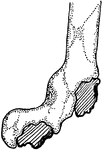
F. Elastica Epidermis
"Cross section of a portion of leaf of Ficus elastica showing the multiple epidermis from e to a inclusive;…

Plant Tissues
"Diagram to show the topography and character of the tissues that evolved from the primary meristems.…

Collenchyma 1 and 2
Developmental stages of collenchyma: "1 and 2, cross and longitudinal section of a collenchyma cell…

Collenchyma 3 and 4
Developmental stages of collenchyma: "3 and 4, longitudinal and cross sections of the same cell at a…

Collenchyma 5 and 6
Developmental stages of collenchyma: "5 and 6, longitudinal and cross sections of a mature cell. The…
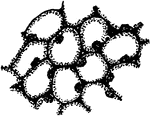
Stone Cells 1
First developmental stage of stone cells: "1, in the primary meristem condition." -Stevens, 1916
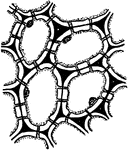
Stone Cells 2
Second developmental stage of stone cells: "2, the cells have enlarged and the walls have begun to thicken…

Stone Cells 3
Third and final developmental stage of stone cells: "3, The walls are completed. The primary wall is…

Bast Fibers 1 and 2
Developmental stages of bast fibers: "1 and 2, cross and longitudinal sections of primary meristem cells…
Bast Fibers 3 and 4
Developmental stages of bast fibers: 3 and 4, cross and longitudinal sections of meristem cells becoming…
Bast Fibers 5
Developmental stages of bast fibers: "5, longitudinal section of completed bast fibers. In 5 the stippling…

A. Ascalonicum Root
"Portion of a cross section of a root of Allium ascalonicum. h, large central, tracheal tube; i, xylem,…

Bast Fibers
"Diagram to show different plans in the distribution of bast fibers. A, bast a continuous cylinder in…
Plant Cell Development 1
First developmental stage of sieve tubes, companion cells, and phloem parenchyma. "A, a and b, two rows…
Plant Cell Development 2
Second developmental stage of sieve tubes, companion cells, and phloem parenchyma. "B, c, companion…
Plant Cell Development 3
Third developmental stage of sieve tubes, companion cells, and phloem parenchyma. "The pits in the cross-walls…
Xylem Development 1
"Stages in the development of the elements of the xylem. A, progressive steps in the development of…
Xylem Development 2
Stages in the development of the elements of the xylem. "B, stages in the formation of tracheids from…

Xylem Development 3
Stages in the development of the elements of the xylem. "C, steps in the development of wood fibers…
Xylem Development 4
Stages in the development of the elements of the xylem. "D, steps in the formation of wood parenchyma…

Vascular Bundles
"Diagram showing how the vascular bundles anastomose around the medullary rays. The gaps represent the…
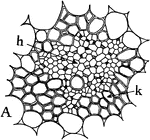
Concentric Vascular Bundle
Types of vascular bundles: "A, the concentric type, with xylem, k, surrounding the phloem, h." -Stevens,…
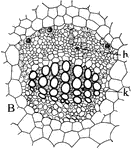
Collateral Vascular Bundle
Types of vascular bundles: "B, the collateral type, with phloem, h, standing in front of the xylem,…

Radial Vascular Bundle
Types of vascular bundles: "C, a portion of the radial type, shown complete in D, where the part outlined…
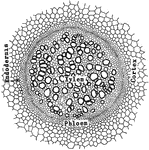
G. Pubescens Stem
"Gleichenia pubescens: transverse section of stem, showing the protostele." -Stevens, 1916
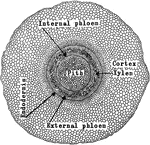
A. Pedaium Stem
"Adianium pedatum: transverse section of stem, showing the amphiphloic siphonostele." -Stevens, 1916
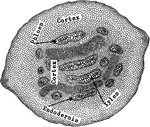
P. Aquilina Stem
"Pteris aquilina: transverse section of stem, showing the polystele." -Stevens, 1916
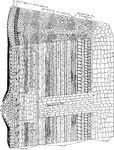
Plant Tissues
"Diagram showing additions to the primary tissues through the activity of the cambium and phellogen…

Plant Tissues
"Diagram showing the relation of this year's leaves to the wood of the current year." -Stevens, 1916
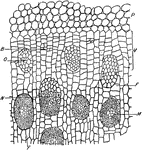
D. Marginata Stem
"Portion of a cross section throughout the stem of Dracaena marginata. P, parenchyma of cortex. V, meristematic…
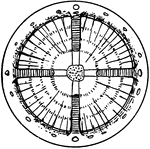
A. Capreolata Unusual Stem Growth
"Diagram showing some types of unusual growth in thickness. A, cross section through a four-year-old…
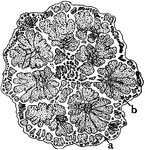
Bauhinia Unusual Stem Growth
"Diagram showing some types of unusual growth in thickness...B, cross section of stem of species of…

G. Scandens Unusual Stem Growth
"Diagram showing some types of unusual growth in thickness...C, portion of a cross section of stem of…

P. Japonica Epidermis
"A, cross section through upper half of leaf of Pyrus Japonica, showing cutinized layer of the outer…

Russian Olive Leaf Epidermis
A cross section through the upper half of a Russian olive leaf, showing a "cutinized layer of the outer…

N. Odorata Epidermis
"C, portion of cross section of submerged stem of Nymphaea odorata, where there is no cutinized layer,…
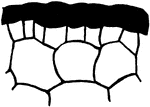
Avicennia Epidermis
"A, portion of cross section of leaf of Avicennia growing in salty soil; outer wall of epidermis very…
Japan Quince Epidermis
"C, cross section through upper half of petal of Japan Quince." -Stevens, 1916
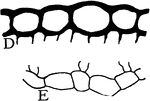
H. Moscheutos Epidermis
"D, upper, and E, lower epidermis of leaf of Hibiscus moscheutos." -Stevens, 1916

Epidermal Outgrowths
"Different forms of epidermal outgrowths. 1, hooked hair from Phaseolus multiflorus; 2, climbing hair…

Multiple Epidermis
"Multiple epidermis of leaf of mangrove in cross section. This serves as a water reservoir, and the…
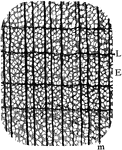
Yellow Poplar Wood
"Cross section of yellow poplar wood. E, early; L, late growth; m, medullary ray." -Stevens, 1916
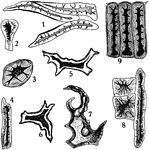
Stone Cells
"Stone cells from different sources. 1, from coffee; 2, 3, and 4, from stem of clove; 5 and 6, from…

Cornstalk Bast Fibers
"Camera-lucida outline of portion of cross section of cornstalk, showing at g bast fiber zone beneath…
Palm Stem
"Cross section of a portion of palm stem. e, xylem; f, phloem portions of vascular bundle; g, sclerenchyma…

Plant Skeletal Tissues
"Diagram showing the progressive development of the skeletal tissues from the apex toward the base of…

Plant Root Hair
"A single root hair on a large scale, showing that it is an outgrowth of an epidermal cell, and the…

S. Oculata Aerial Root
"Portion of cross section through an aerial root of Stanhopea oculata. h, the velamen; i, exodermis;…
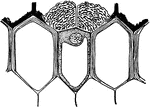
S. Macrantha Aerial Root
"Showing at f the felty body covering the passage way through the exodermis of the aerial root of Sobralia…

T. Usneoides Cell
"Cross section through a water-absorbing scale of Tillandsia usneoides; a, a, water-absorbing cells…

Palm Stem
"A, diagram of course of vascular bundles in a palm stem; 1m, 2m, 3m, bundles from the median portions…

Cerastium Stem
"B, diagram of vascular bundles in external view and in cross section of the stem of Cerastium. The…

C. Viticella Stem
"Diagram showing the course of the vascular bundles in a stem of Clematis viticella. Median bundles…

Pit Development
"Different stages in the development of a bordered pit. b, The original, thin, primary wall; a, the…
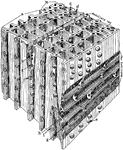
Magnified Pine
"Diagrammatic representation of a block of pine wood highly magnified. a, Early growth; b, late growth;…
Water Flow in Plants
"Diagram showing the relation of the water-carrying tissues of the leaves to those of the stem, and…


